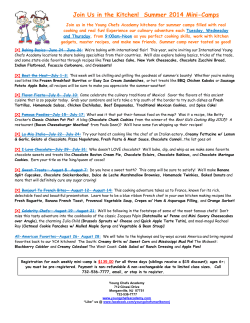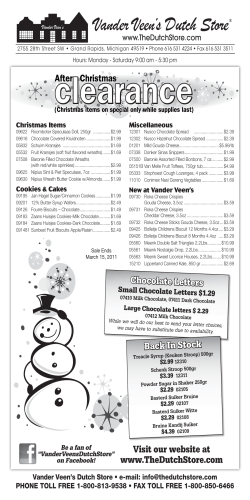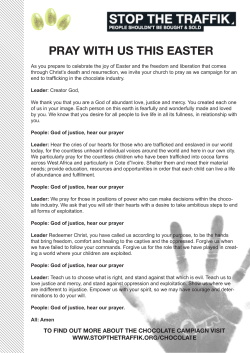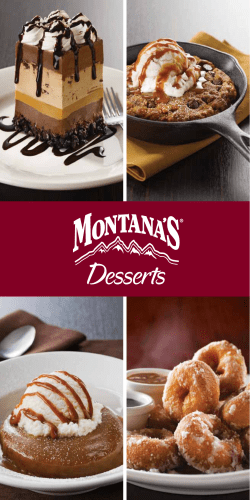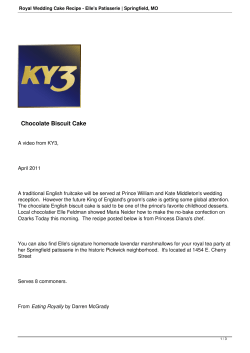
Raw Chocolate Oooosha A passion for By Amy Levin
Oooosha SAMPLE To Purchase the complete version of this Ebook Click here A passion for Raw Chocolate By Amy Levin Foreword by Chad Sarno www.ooosha.co.uk Introduction This book covers the fundamentals of precise raw chocolate making and outlines the following topics, techniques and principals: Tempering – explains the tempering process, various ways to temper and why tempering is a crucial part of chocolate making Chocolate moulds – the different types, how to use them, how to care for them and where to buy them Base recipes for white, “milk”, dark and “pure”(using nibs) chocolate – all dairy free Sweetener chart of all sweeteners to use in raw chocolate and in what amounts How to make coloured chocolate and explanation of various decorating methods Ooosha’s “Signature” Chocolate recipes Creating and using textures and aroma to create truly unique raw chocolates Troubleshooting section of FAQ’s on tempering and general chocolate making Links page to help you find everything you require to get started; moulds, ingredients, equipment and inspiration www.ooosha.co.uk 3 Table of Contents Foreword by Chad Sarno >6< A few words by Amy Levin >7< A great history Cacao through the ages >8< The essential ingredient Cacao in all it’s glorious forms >9< Melts in your mouth Chocolate-making processes > 10 < Mise en place Getting prepared to make chocolate > 11 < Tempering What, why and how > 12 < Chocolate Moulds Using them, caring for them and the various types > 18 < Let the journey begin Making chocolate, sweetener chart and cacao percentage formula > 21 < CONTINUES www.ooosha.co.uk 4 Sweetener Chart A rough chart to sweeteners > 26 < Making your chocolates unique and the creative process of recipe development > 28 < Colours & Decorating Making and using coloured chocolate > 29 < Texture & Aroma Individualizing your chocolates, standing out from the rest > 33 < Ooosha’s Signature Chocolate Recipes Tried, tested and adored > 36 < Troubleshooting Frequently asked questions answered > 49 < Nutrition and Chocolate The nutritional benefits of chocolate > 53 < Useful links For inspiration, ingredients, tools, techniques and more > 56 < About A little bit about the author > 57 < www.ooosha.co.uk 5 Foreword N OW, lets be honest. No matter what dietary path one follows, what your cultural upbringing, age, or food beliefs may be, one thing is certain; we all love chocolate! If you are shaking your head saying, ‘no way, not me’, we both know that you are in total denial and are just a closet lover of all things chocolate like the majority of the population. I am the first to admit it, personally I fit within the ‘majority’ category and have a love affair with any recipe that boasts clean, raw chocolate on occasion. My passion for scratch cooking runs deep. I thrive on it, and it drives me to push myself to those culinary corners that are less familiar, letting the ingredients talk me through the process of creating. There is nothing better than spending the day in my kitchen developing, or cooking a recipe that is such a staple food that we tend to purchase pre-made so often, such as home made breads, fresh pasta, and of course chocolate. There are many resources, and cookbooks out there that support this creative flow in the kitchen but very few that are bold enough, and have the experience behind them as the info in this packed ebook does when venturing into this sexy world of decadence. Over a span of about 6 years throughout the EU, with dozens of trainings, tons of large culinary events and launching 5 plant-based restaurants throughout Europe, from Istanbul, to Munich and London, I have been able to reap the benefits first hand of Amy’s skills heading up the pastry menus, or rocking out service together with our team behind the line. The finish to any meal, especially a multi course menu is truly the finale of the experience for the diner, and for this course I would trust Amy, with her passion, and willy wonka creativity to wrap up the menu, or evening with a sweet bow and a chocolate kiss to send the diner home on a cloud of euphoria and total completion. Amy is a force in the kitchen and her work was a massive contribution to the menus we offered at those restaurants. She is not only my favorite raw pastry chef, but also a dear friend. I continue to be amazed by the innovation she continues to share with the world in the realm of raw chocolate and pastry. Try it for yourself, and trust me, you will not be disappointed, you are in good hands and that sweet tooth of yours and dinner guests will be very grateful you dove into this book as well. Chad Sarno Chef. Educator. Plant Pusher. www.chadsarno.com www.ooosha.co.uk 6 A few words T HE production of raw chocolate has come a very long way in the past 10 years, it used to be that dates and cacao nibs mixed together somewhat haphazardly in the food processor was considered raw chocolate. These days, people are learning how to create raw chocolate which is just like cooked; with the shine, snap and melt-in-yourmouth feel. My journey has been to educate as many people as possible in making raw chocolate to the highest possible standard using superior quality ingredients and their limitless imagination to create uniquely presented, flavoured and packaged chocolate; to turn even the biggest skeptic into a raw chocolate lover. My hope is that through reading this book, and applying the techniques and principles outlined, you too will be on the road to making the best raw chocolate you have ever tasted. For those of you who have been making raw chocolate for a while, the skills outlined in this book will propel you into a whole other level of raw chocolate creation and answer all the questions to problems you have had over the years. If you are new to raw chocolate making, then this book will serve as an educational resource and priceless tool on your raw chocolate journey; teaching you everything you need to know from commercial production methods to making and using coloured chocolate to achieve professional results that you can be proud of. I see raw chocolate and desserts of any kind as a gateway food; if you can attract people to healthy eating through beautifully presented and executed desserts and chocolates then you are on the road to changing the way they view “health food” and “healthy eating”. If you can open one persons mind to the possibility that exists in making healthier food choices, then you are making a huge difference in the world, maybe not all at once, but one at a time, step by step. I am truly excited for you and the chocolate journey that lies ahead and it is a journey. Don’t fool yourself into thinking that you will be a pro overnight. Becoming a master chocolate maker happens over the course of many years and through much trial and error. Enjoy the journey. Enjoy the learnings that come from discovering yourself through chocolate. Above all, have fun! Amy Levin www.ooosha.co.uk 7 A Great History Unknown Monkeys are said to have been the 1544 AD Dominican friars took a group of Kekchi bringers of wild cacao trees; by eating the fruit and spitting the seeds (cacao beans) onto the ground. Thus, planting the first seeds! In Costa Rica, Panama, Peru, and Brazil Squirrel Monkeys, Capuchins, and Spider Monkeys feed heavily on the fruit of cacao trees Mayan nobles to visit Prince Philip of Spain. The Mayans brought gift jars of beaten cacao, mixed and ready to drink. The Spanish began to add cane sugar and flavourings such as vanilla to their sweet cacao beverages. 1500 BC – 400 BC Olmec Indians are believed 1585 AD The first commercial shipment occurred to be the first to grow cacao beans as a domestic crop when a load of beans was sent from Veracruz, Mexico to Seville. For almost 100 years, preparation of the drink remained a Spanish secret, until... 400 BC – 200 BC Archaeological evidence in Costa Rica indicates that cacao was drunk by Maya traders 600 AD Mayans migrate into northern regions of South America establishing earliest known cacao plantations in the Yucatan 200 BC – 1550 AD Mayan’s raised and traded cacao as a valuable commodity. Cacao was grown both in house gardens and in plantations 1376 AD – 1520 AD Cacao beans were both a valuable commodity, and a major form of currency in the Aztec empire 1502 AD Christopher Columbus, the first outsider to drink chocolate, is said to have brought back cacao beans to King Ferdinand from his fourth visit to the New World, but they were overlooked in favour of the many other treasures he had found. 1519 AD Chocolate was first noted when Spanish explorer Hernando Cortez visited the court of Emperor Montezuma of Mexico. Montezuma is said to have drank 50 goblets of cacao beverage per day as it was believed to bring strength and power to those who drank it. 1528 AD Cortez brought chocolate back from 1606 AD …it was finally introduced into Italy in by Antonio Carletti and from there into France. The beverage soon became very popular, and chocolate houses spread all over Europe. 1657 AD The first "English Chocolate House" opens in Great Britain for chocolate drinking 17th – 18th Centuries Chocolate was thought to be both nourishing and an aid to digestion. In the late 17th century, chocolate houses appeared in London, alongside already flourishing coffee houses. Coffee and chocolate houses were often the scenes of gambling, political intrigue and general dissipation. 18th Century Mixing chocolate with milk instead of water was struck upon by Sir Hans Sloane, personal physician to Queen Anne. His secret recipe, eventually sold to a London apothecary, at a later date was acquired by the Cadbury brothers. 1879 Daniel Peter and Henre Nestle introduce milk chocolate to the world. 1879 Rodolphe Lindt, the founder of Lindt Chocolates, invented the process of “Conching” which is used to refine chocolate thus enhancing it’s quality. Mexico to the royal court of King Charles V. along with the secret recipe for xocoatl (chocolate drink) Monks, hidden away in Spanish monasteries, processed the cocoa beans and kept chocolate a secret for nearly a century. www.ooosha.co.uk 8 The Essential Ingredient Cacao in all its glorious forms Cacao Beans Cacao Liquor Cacao beans come from the Cacao Fruit which grows in places like The Ivory Coast, Mexico and Spain. The beans are surrounded by fruit within the pod and, when eaten out of the pod, the beans bitterness is offset by the sweetness of the surrounding fruit; natures original chocolate treat. These beans are removed from the pod and, in all cooked chocolate production, but not raw, the beans are then fermented and dried (or roasted). Both the fermentation and roasting processes bring forth the layers of flavour present in the cacao bean. Without these processes, the resulting chocolate confections will be delicious, but will not be suitable for chocolate tasting to identify it’s various flavour notes. Is made by grinding the beans in an industrial machine into a fine paste. During this process, the cacao will be heated unless specific raw techniques are applied to keep the machine cool, therefore keeping the processing of the beans within 42c. From here, this paste is either set and sold as is or further processed to make cacao powder. (see below) This is not an ingredient used in this book, but one I encourage you to experiment with it if you feel drawn to do so. Cacao Nibs In raw processing techniques the beans are generally not fermented. The beans are sun dried on massive roofs and raked over throughout several days for consistent drying. Once dry, they are transported to a factory where the skins are removed by shooting the beans against a wall with a fan blowing against them to sweep the skins away as the beans shatter against the wall into nibs. These nibs are then either packed as is or used by some commercial raw chocolate companies to make raw chocolate bars. The cacao skins are used in animal feed. Cacao Powder & Butter To make cacao powder, the press (as mentioned above) extracts 75% – 90% of the fat (cacao butter) from the chocolate liquor. The remaining cake is then ground and sifted through fine nylon, silk, or wire mesh and used to make cacao powder. In my chocolate classes, there is generally a question of the flavour notes present in differing cacao powders. These chocolate flavour notes develop when the beans are fermented and roasted. Raw chocolate powder generally does not contain these flavour notes, unless the nibs are fermented, which is uncommon in raw chocolate production. Choices I buy all of my cacao products from Tree Harvest, as mentioned on the Links page. I buy Ecuadorian or Peruvian butter, nibs and powder as I find them to be the most consistent in flavour and the most reasonably priced. They also carry Balinese cacao products which I, and many I have spoken to, find low quality and tasting, rather surprisingly, burnt. If you are able to choose between Criollo, Forastero and Trinitario cacao products, choose Criollo as it’s the Arabica coffee bean of the cacao world; the very finest. www.ooosha.co.uk 9 Melts in your mouth The process of making commercially produced chocolate, raw or cooked, and why the texture is so different from domestically/artisan produced chocolate. F IRST time raw chocolate tasters generally have the same issue to report; it’s grainy and it doesn’t melt in your mouth like cooked chocolate. Here is a short explanation both for you to understand and for you to convey to those eating your chocolate, if you wish. The process of commercial chocolate making is the same regardless of whether you are making raw or cooked chocolate; Commercial machines can be set at low processing temperatures. In chocolate factories, a conching machine is used to first process the chocolate. This machine differs depending on how simple or advanced it is, but the premiss remains the same; to grind the chocolate for long periods of time in order to achieve as smooth a consistency as possible. Companies like Lindt conch their chocolate for 72 hours, the longer the chocolate is conched, the more easily it dissolves into your tongue, as the cacao particles become microscopic. For smaller companies, who only have one small conching machine, they may only conch their chocolate for 8 – 12 hours so they are able to produce more chocolate per week. This will of course yield a more “grainy” texture on the tongue. Of course, conching is not the only factor at play here, large companies use emulsifiers, milk powders and so on to make their chocolate smooth and silky. It’s also important to understand that the idea of making your chocolate from scratch (nibs, cacao butter, cacao powder, sweetener, etc…) is not very common in cooked chocolate making, specifically for at home cooks, but even for large chocolate companies. Instead, they would purchase couverture, small rounds (or in commercial terms, large blocks) of tempered chocolate, which they would melt down and use as they wish for enrobing, ganache, mould casting, etc… Raw chocolate is not yet sold as couverture, unless you buy bars of tempered plain chocolate and use that, so we make our own and that is exactly the process which will be outlined and taught in this book. When processing chocolate at home using these techniques, you are blending it for maximum of 3 minutes – any longer than that and you would heat the chocolate above raw temperatures. That is a massive difference to 72 hours, so you can see why the texture is so very different. This is an interesting thing to remind your friends, family or customers of as well. www.ooosha.co.uk 10 Texture and Aroma O N the pages to follow, you will find recipes for some of my “signature” chocolate recipes. You’ll notice that each recipe has at least one texture and, in some cases, there are two different textures; soft, chewy and/or crunchy and a scent, aroma or flavour that runs throughout the entire bar so you get a burst of flavour in each bite, even if you don’t get texture. When creating new flavour combinations, you want to consider the full experience for the consumer; appearance (using colour, achieving shine, packaging), aroma/smell (essential oils, flavour extracts, fresh herbs), texture (crunchy, chewy, soft, smooth) and taste (sweet, dark, bitter, floral, so on) – In most cases, chocolate you create for a child, for example, will be very different to the chocolate you create for an adult. www.ooosha.co.uk 33 Oosha’s Signature Chocolates The following recipes have been perfected over many years, through much trial and error and are some of my favourite chocolate combinations of all time. Through applying the principles and techniques outlined in this book, you too will create a “signature” line over the coming years. It takes practice, patience and imagination; we all have those three traits, just need to tap into them through the muse of chocolate. www.ooosha.co.uk 36 SAMPLE To Purchase the complete version of this Ebook Click here www.ooosha.co.uk
© Copyright 2026
